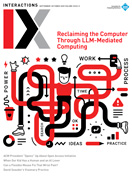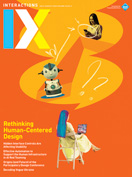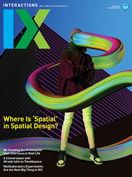Authors:
Gopinaath Kannabiran, Jodi Forlizzi
AI technologies play an increasingly important role across various sectors. How might we design AI technologies that can aid compassionate interactions? Why is it necessary to take a compassionate design approach? In this article, I explore how these questions relate to worker well-being in a conversation with Jodi Forlizzi.
The Sanskrit word karunā refers to an important concept in Indian spiritual traditions and is commonly translated in English as compassion. Moving away from an individualistic worldview, karunā emerges from a worldview that everything is interconnected. It is a profound recognition of our entangled existence that urges us to help alleviate the suffering of others in order to ease our own suffering. The concept of karunā is echoed in the words of the American voting and women's rights activist Fannie Lou Hamer: "Nobody's free until everybody's free."
Despite being recognized as an important virtue across cultures, a practical definition of compassion is often found wanting. Clara Strauss and colleagues bring together Buddhist and Western psychological perspectives to describe the elements of compassion: recognition of suffering in others, understanding the shared humanity and universality of suffering, feeling emotional resonance (sympathy, empathy, and concern) for those who suffer, tolerating the distress associated with the witnessing of suffering, and motivation to act or acting to alleviate the suffering [1].
 Designing for and with Compassion
Designing for and with Compassion
Advancing an ecological worldview, a compassionate design approach refutes saviorist attitudes and instead promotes collaboration and cooperation. Exploring designing for resilience in HCI, Dorian Peters and Rafael Calvo point out that "while empathy may lead to an inward focus and/or aversive response, as one is absorbed by an experience of vicarious negative emotion, compassion describes an outward focus and an active caregiving response" [2]. Peters and Calvo assert that if "design of technologies can encourage the development of compassionate attitudes and elicit compassionate states in the face of social problems, we will not only help to address those problems, but also improve the well-being of all involved" [2]. In a more recent work, Mark Graves and Jane Compson explore compassionate AI for moral decision making, health, and well-being: "By making AI compassionate, the alleviation of suffering becomes explicit, rather than proxied, and potential harms caused by AI automation can be turned into benefits" [3]. The authors suggest that compassionate AI can be deployed "especially into application areas where compassion plays an essential role with high demands on the compassion capacity of caregivers" [3]. Building on existing efforts that advocate for a compassionate approach to the design of AI technologies, here we turn our focus toward worker well-being.
Designing AI technologies for well-being is essential and yet remains elusive.
Gopinaath Kannabiran: Can you tell us a little about your work and how you approach worker well-being?
Jodi Forlizzi: I am currently studying how AI and automation affects workers. I am particularly interested in face-to-face service workers who often confront various systemic sociotechnical challenges that may hinder their ability to work and negatively affect their lives. The focus on how technology affects their work is part of a larger investigation on well-being at work. We have defined worker well-being as feeling agency and self-sufficiency in their roles, having control over their workflow, having positive communication and interaction with other employees and managers in the workplace, and being appropriately trained on the technology systems that they are asked to use in the workplace. This definition is based on themes that were elicited by analyzing interview and observation data collected in several hotels.
GK: Your definition of worker well-being invokes multiple themes that are relevant for HCI and CSCW: agency, participation, power inequity, self-sufficiency, collective empowerment, communication, and upskilling, among others. I have argued for conceptualizing "self as always-already-relational and well-being as an ongoing contestation of power" [4] in a conversation with Heather McKinnon about designing for living well. In one of your recent works, you and your coauthors suggested that "focusing on well-being in the hospitality industry may help with retention efforts where solely relying on wage increases would have not sufficed" [5]. This insight reaffirms my conviction that an individualistic worldview is inadequate while designing technologies for well-being.
What are some challenges and frustrations you encounter while designing for worker well-being? And what keeps you moving forward?
JF: In the aforementioned project, we encountered a lot of bumps and hiccups in studying service workers and their work. While training and digital and AI literacy are part of the problem, there are also issues in how technology is designed, developed, procured, and rolled out. Many approaches to worker well-being do not take the holistic view that is needed. We know that surfacing the voices of workers can positively affect worker well-being. The work is exciting and rewarding, so it helps us move forward, even though finding sites to study can be difficult and time-consuming.
GK: Worker well-being includes complex issues, such as alienation, increasing demands at work, work precarity, unfair labor practices, and digital divide. As you mention, it is vital to design technologies with a holistic perspective that encompasses our embodied, emotional, intellectual, social, and spiritual interactions with others. Suffice to say, designing AI technologies for well-being is essential and yet remains elusive. I am particularly interested in approaches that acknowledge people's vulnerabilities and work toward supporting them as agents of change in their own lives. I agree with you that it is necessary to surface the voices of workers and pay attention to how they face inequities. This kind of approach makes it possible to critically question existing labor practices and can support compassionate exploration of better alternatives for worker well-being.
In a panel discussion with the environmental philosopher Glenn Albrecht, I highlighted that "people who engage with social justice related issues and environmental concerns through their work often experience ecological burnout [and therefore] it is necessary to process our eco-burnout through communal body-based practices" [6]. You are a martial arts practitioner and yoga teacher. How does this influence your work?
JF: It is critical to enter research collaborations and field sites with as little bias as possible so we can understand the system of study and provide the best future for those we intend to assist in our research. Movement arts, such as martial arts and yoga, have taught me how to feel a deep empathy and understanding for others, whether they are the subjects of research or my academic collaborators. They've also helped me understand any interaction with another human as a dialogue from which one can learn.
For the past five years, I have been a regular columnist for Interactions, exploring a variety of design-related issues. Writing for the flagship magazine of the ACM Special Interest Group on Computer-Human Interaction, which has a global reach with diverse audiences, has been a challenging and rewarding responsibility. I have grown as a public scholar and writer because of this privilege. Writers yearn for meaningful conversations with their readers. Conversing with readers who have reached out to me after reading a piece I wrote has been deeply fulfilling and fueled me to keep writing. After five years, I would like to pass the baton onto others. I am deeply grateful for the critical feedback and unwavering support I have received from readers, friends, colleagues, and the entire Interactions editorial team, without whom this would not have been possible. Thank you.
1. Strauss, C. et al. What is compassion and how can we measure it? A review of definitions and measures. Clinical Psychology Review 47 (2016), 15–27; https://doi.org/10.1016/j.cpr.2016.05.004
2. Peters, D. and Calvo, R. Compassion vs. empathy: Designing for resilience. Interactions 21, 5 (2014), 48–53; https://doi.org/10.1145/2647087
3. Graves, M. and Compson, J. Compassionate AI for moral decision-making, health, and well-being. Proc. of the 2024 AAAI/ACM Conference on AI, Ethics, and Society 7, 1 (2024), 520–533; https://doi.org/10.1609/aies.v7i1.31655
4. Kannabiran, G. and McKinnon, H. Design and living well. Interactions 30, 4 (2023), 44–48; https://doi.org/10.1145/3600104
5. Spektor, F. et al. Designing for wellbeing: Worker-generated ideas on adapting algorithmic management in the hospitality industry. Proc. of the 2023 ACM Designing Interactive Systems Conference, ACM, 2023, 623–637; https://doi.org/10.1145/3563657.3596018
6. Kannabiran, G. Yoga for eco-burnout. Medium, Apr. 8, 2024; https://gopinaath.medium.com/yoga-for-eco-burnout-cd0a36106880
Gopinaath Kannabiran is an HCI researcher, design educator, sexual rights activist, and tantra yoga teacher. His work explores how the design of technology might aid various dimensions of holistic well-being through interdisciplinary approaches. [email protected]
Jodi Forlizzi is the Herbert A. Simon Professor of Computer Science and Human-Computer Interaction in the School of Computer Science at Carnegie Mellon University. She studies the ethical impacts of human interaction with AI systems in front-line service industries, including healthcare and hospitality. She is an ACM SIGCHI Fellow and recently received its Lifetime Research Award. [email protected]
Copyright 2025 held by owners/authors
The Digital Library is published by the Association for Computing Machinery. Copyright © 2025 ACM, Inc.







Post Comment
No Comments Found